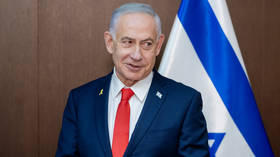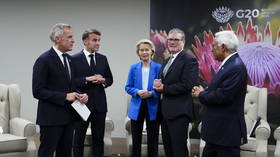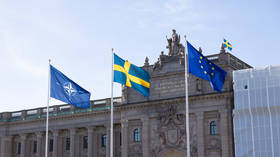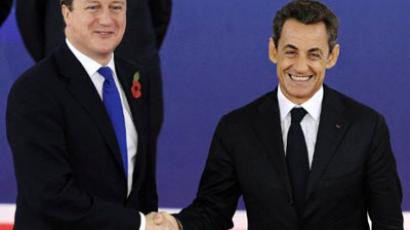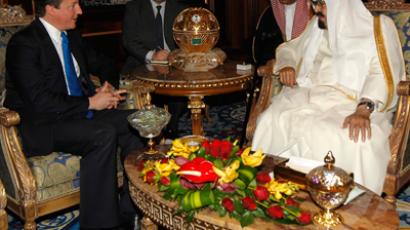Guns for buddies: US weapons sales surge overseas

US foreign military sales have shot over $50 billion. Another record-breaking year is expected thanks to US ally Saudi Arabia, which accounts for three-fifths of the sum.
"We have already surpassed $50 billion in sales in the fiscal year 2012," Andrew Shapiro, assistant secretary of state for political-military affairs, told journalists on Thursday.Though it is three months till the end of the fiscal year, the figure already shows a 70 per cent increase over government-to-government military deals in 2011. Last year also set a record for the US with sales at some $30 billion. “The sale to Saudi Arabia was very significant,” said Shapiro. The $29.4 billion deal finalized in December included 84 new fighter jets and the modernization of 70 old jets.Former Canadian diplomat Peter Dale Scott told RT that Saudi’s big contribution to Washington’s revenues may be explained by the long standing “arms for petrol” relations between the two countries.“During the oil price hikes of 1971 and 1973 the US negotiated an agreement to pay Saudi Arabia higher prices for crude, on the understanding that Saudi Arabia would recycle the petrodollars, many of them through arms deals,” said Professor Scott. “So recently the imports of American hardware to Saudi Arabia have grown significantly.”The record-breaking figure also includes the sale of the Joint Strike Fighter to Japan, which is valued at approximately $10 billion, according to the State Department.As for direct commercial sales, whereby companies sell directly to foreign governments as opposed to government-to-government sales, an official report released the previous week only accounts for 2011. That year brought US contractors some $44 billion with top customers including Jordan, Japan, Israel, Afghanistan and Pakistan.
How to join the US gun club
Shapiro also pointed out that weapons sales are licensed “to serve foreign policy interests” and brought up the trend of tying defense contracts to diplomacy. Countries willing to buy from the US have to be sure “about the nature of the relationship” with Washington.“When a country buys an advanced US defense system through our foreign military sales, direct commercial sales or foreign military financing programs, they aren’t simply buying a product. They are also seeking a partnership with the United States. These programs both reinforce our diplomatic relations and establish a long-term security relationship,” said the official.Can this mean that a country importing US weapons may fall under America’s influence?“Yes, this link may be correct,” observed Professor Scott. “Hosni Mubarak’s Egypt, for instance, was the third-largest recipient of the US aid, which arrived in the shape of finances and arms. In return, Cairo granted security in the region, which first meant acceptance of Israel.”Whether 2013 see a further increase in foreign military sales is “too early to predict,” says the US State DepartmentThe US is expected to continue expanding into key markets, including India, which is considering a $1.4 billion deal for 22 Apache helicopters. The US Defense Security Cooperation Agency is also eyeing military sales of more than $1.1 billion to Qatar and Oman, reports ArabianBusiness.com. Qatar is considering purchase of Black hawk helicopters and missile-warning systems, while Oman might be buying missiles and military training kits.
Free weapons for Russia’s backyard?
However, it appears that some Asian countries can get US weapons for free, a report in the Russian daily Kommersant reveals. The Pentagon is engaged in talks with Kyrgyzstan, Uzbekistan and Tajikistan to hand over some of their military hardware after NATO troops quit Afghanistan in 2014.This would mean distributing armored vehicles, tank trailers, tankers, medical equipment and communication tools – everything which is not worth sending back home due to high transport costs. Pakistan, affronted by continuous drone strikes, has pushed up fees from $250 per container to $5,000.The US reportedly intends to give away some of its equipment for free, while some of it is to be left behind for secure storage, as it may prove to be of need later – for new operations in Afghanistan or Pakistan or other Central Asian countries. Kyrgyzstan has confirmed negotiations are under way, but officials do not believe they will get anything valuable.“This is done to study the three countries leaders’ reactions as well as the reaction of the Shanghai Cooperation Organization and Collective Security Treaty Organization,” an unnamed official in the Kyrgyz Defense Ministry told Interfax news agency.Meanwhile, the prospects of finding US military hardware in neighboring countries have reportedly thrust Moscow into “utter bewilderment.”“This kind of scenario is totally unacceptable for Russia. It would contradict our arrangements with Central Asian partners and violate our agreement within the Collective Security Treaty Organization,” a diplomat told Kommersant.





